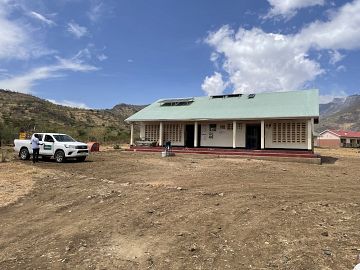Scientific modelling for malaria policymaking
20 April 2022 Nadumget health facility, Moroto, Uganda, 2022
Nadumget health facility, Moroto, Uganda, 2022Researchers from the Swiss Tropical and Public Health Institute (Swiss TPH), Uganda National Malaria Control Division (NMCD) and Malaria Consortium have co-authored an opinion piece on future malaria modelling and policy shifts, which was published in Nature Medicine last month.
Swiss TPH developed the OpenMalaria modelling platform to simulate the impact of malaria interventions in a variety of settings. Their study considered the deployment of seasonal malaria chemoprevention (SMC) - a highly effective intervention to prevent malaria in children under five - outside the Sahel, where implementation has been focused over the past eight years. Swiss TPH Infectious Disease Epidemiologist, Dr Branwen Nia Owen, commented on why she led the research:
“I was really inspired by Dr Pedro Alonso's article calling on the malaria community to take bold action and harness scientific tools to fight malaria. Bold action, like trialling SMC outside of the Sahel for the first time, is often difficult and expensive. Dynamical modelling can be a relatively easy and cheap way to assess the viability of a plan, and to explore any likely pitfalls, without working through them all in real life.”
To date, the Sahel region of west and central Africa has been prioritised for the scale-up of SMC because of concerns over widespread resistance to sulfadoxine-pyrimethamine (SP) and amodiaquine (AQ) (SPAQ), the antimalarials commonly used in SMC, across much of east and southern Africa. However, there have been increasing calls to expand this successful intervention to new geographies, including areas in east and southern Africa where malaria transmission is highly seasonal.
As a leading implementer of SMC – reaching over 20 million children in 2021 – Malaria Consortium, together with national malaria programmes in Mozambique and Uganda, has been conducting implementation studies to explore if SMC can be a viable malaria prevention strategy in those countries. Dynamical modelling was used to contribute to this research in the Karamoja region of Uganda to model the impact of SMC deployment in the region, assuming implementation of five monthly cycles of SMC with SPAQ from May to September and a series of alternative scenarios.
Craig Bonnington, Senior Technical Advisor at Malaria Consortium, added:
“As we consider expanding SMC to new geographies with variations in antimalarial drug resistance, transmission, baseline prevalence and population immunity, we recognise that a one-size-fits-all approach is no longer appropriate for SMC. We cannot assume that the effectiveness we observed in West Africa will apply to new malaria ecologies. Using dynamical modelling helps us to understand how new parameters may affect the utility of SMC as an intervention in new locations, carefully considering a new mix of important variables."
Keywords: Resistance management | Monitoring and evaluation | Research
Related content
23 April 2021
Our research strategy for seasonal malaria chemoprevention
7 July 2021Photo story: SMC beyond the Sahel: Protecting children from malaria in Uganda
9 December 2021Taking seasonal malaria chemoprevention to new geographies: Promising findings from Uganda and Mozambique
25 January 2022SMC in 2022: Maintaining scale and looking to the future
Latest news
- Malaria Consortium honoured by Ugandan government for contribution to combat malaria23rd April 2024
- International summit calls for AMR accountability in public health interventions21st March 2024
- Global SMC community celebrates new milestone at SMC Alliance Annual Meeting in Nigeria6th March 2024
- Scaling up key interventions could halve pneumonia-related childhood mortality13th February 2024
- Malaria Consortium and eGov Foundation join Mozambique’s national malaria programme to digitalise seasonal malaria chemoprevention campaigns8th February 2024
- World’s first malaria vaccine rollout launched in Cameroon22nd January 2024